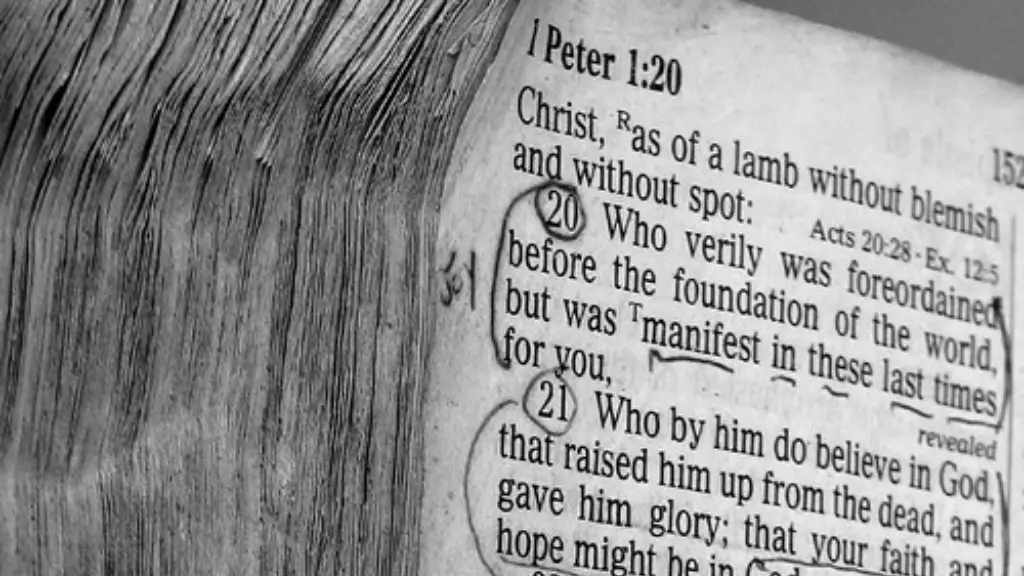The Bible refers to many creatures that have proven to be merely mythical, such as the phoenix, but does it really talk about unicorns? This is a question that has long been asked, and the truth is that there are arguments for both sides. Some claim that the Bible does talk about unicorns, while others disagree. In order to get to the bottom of this debate, it is important to look at the passages in detail and draw your own conclusions.
The first place to look is the King James Bible, which mentions unicorns twice. One reference is in Numbers 23:22, where it is described as an “ox of three-fold strength”. The second is in Deuteronomy 33:17, where it is said that “his horns are like the horns of an unicorn”. On the surface, these two references seem to suggest that unicorns are real creatures that exist in the Bible.
However, there is a problem with this interpretation. The Hebrew word for “unicorn” used in these passages is “re’em”. Scholars have long disagreed about the true meaning of this word and the most likely explanation is that it simply referred to a large powerful beast, such as an ox or a bull. This would suggest that the unicorns mentioned in the Bible weren’t actually unicorns, but some other type of creature.
The other explanation for the references to unicorns in the Bible is that they are symbolic figures. Some commentators have argued that they represent Christ, who is described as having “horns of salvation” in the New Testament. Others have argued that they are meant to denote strength and power, or even spiritual purity.
In order to make a final judgment on the subject, it is important to look at the context of the passages. In both of the passages mentioned earlier, unicorns are used as a metaphor to describe something else. This suggests that they were not meant to be taken literally, and thus the references to unicorns in the Bible are more likely to be symbolic rather than literal.
So, does the Bible really talk about unicorns? The answer is a resounding “maybe”. While there are passages that could be taken to refer to unicorns, the most likely explanation is that these references are symbolic rather than literal. Ultimately, it is up to the individual to decide what he or she believes about the Bible and its references to unicorns.
Unicorn Symbolism in Ancient Cultures
Unicorns have a long and storied history in many different cultures around the world. For example, ancient Greek and Roman texts describe the unicorn as a fearsome beast, while in Chinese mythology the unicorn is viewed as a symbol of luck and good fortune.
In the Middle Ages, unicorns were often seen as symbols of purity, and it is believed that the medieval Christian church used unicorns as symbols to represent chastity and purity. This symbolism carried into modern times, and even today many people still view the unicorn as a symbol of innocence and purity.
Interestingly, the Christian church also drew heavily upon the symbolism of the unicorn when the Bible was first translated. In fact, the first use of the word “unicorn” to describe a creature in English was by the King James Bible in 1611. The Bible does not actually mention unicorns by name, but the translators used the word “unicorn” to represent the Hebrew word “re’em”.
The word “unicorn” carries a powerful and mysterious aura, and it is likely that this was an intentional choice by the Bible translators. This adds to the idea that the references to unicorns in the Bible were meant to be symbolic rather than literal.
Modern Acceptance of Unicorns
Today, the unicorn has become something of a pop culture icon. It is featured in books, movies, television shows, and even advertisements. This acceptance of the unicorn as a real creature is partly due to the influence of the Bible. Many people interpret the Bible’s references to unicorns as evidence of their existence, despite the fact that scholars disagree on the matter.
The modern fascination with unicorns also speaks to the fact that they are seen as symbols of power, beauty, and innocence. In our increasingly cynical and jaded modern world, these creatures offer an escape from the harsh realities of life. For many people, the unicorn is a reminder of simpler times, when anything was possible.
It is interesting to note that differences of opinion still exist when it comes to the real-world existence of unicorns. While some people accept them as real creatures, others view them as merely fictitious. But regardless of your opinion on the matter, one thing is certain – the unicorn is here to stay.
Unicorns in Ancient Art
The unicorn has permeated art for centuries, and can be seen in numerous works from different cultures across the world. For instance, in ancient Roman mosaics and wall paintings, the unicorn is usually surrounded by figures like Pegasus and the Minotaur, and is depicted as a strong and powerful creature.
In the Middle Ages, unicorns were a popular subject in Christian art. They were often used to illustrate religious scenes and teachings, and were thought to be a symbol of spiritual purity. This symbolism was also present in literature during the medieval period, and poetic works such as the Middle English “Sir Orfeo” feature unicorns as benevolent creatures.
In more modern times, the unicorn has become a popular subject in fantasy art. This is particularly true in the works of certain fantasy authors, such as J.R.R. Tolkien, who included unicorns in his books “The Lord of the Rings” and “The Hobbit”. Unicorns also appear in many contemporary films and television shows, such as “Harry Potter” and “Legend of the Guardians: The Owls of Ga’Hoole.”
The Power of Unicorns in Pop Culture
The unicorn has had a powerful impact on our culture in recent years. Its image has been used to sell products ranging from clothing to toys, and its distinctive horn has been turned into a popular symbol of power and beauty. It is no surprise then that the unicorn was recently selected as the national animal of Scotland.
The unicorn’s impact has even been felt in modern music. For instance, the band Lady Gaga recently released a single called “Bad Romance” which includes a line referencing unicorns. Similarly, popular singers such as Taylor Swift and Katy Perry have both released songs with references to unicorns.
There is no doubt that the unicorn has become one of the most iconic figures in pop culture. Its presence can be seen in almost every aspect of our lives, from books and television to music and art. It is clear that the mythical creature has transcended its biblical roots and become an important part of modern society.
What Does the Future Hold for Unicorns?
Although it is impossible to know for sure, it is likely that the unicorn will remain a popular figure for many years to come. Its image is one that will continue to be used in media and advertising, and it will continue to be used as a symbol of purity and strength.
It is also worth noting that the unicorn is a creature that transcends age. Children are particularly taken by the creature, and it is easy to see why – its appearance is gentle and beautiful, and its mythology surrounds it with an air of mystery and enchantment. Even in our increasingly cynical world, we can all appreciate the sense of wonder that unicorns can bring to our lives.
In the end, whether or not unicorns are real creatures is beside the point. The unicorn is still an important part of our culture, and its presence will continue to be felt in the years to come. As we all know, legends never die – and neither do unicorns.





